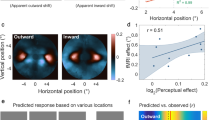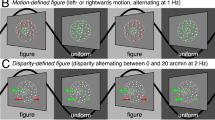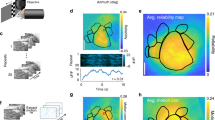Abstract
Exploring visual illusions reveals fundamental principles of cortical processing. Illusory motion perception of non-moving stimuli was described almost a century ago by Gestalt psychologists1,2. However, the underlying neuronal mechanisms remain unknown. To explore cortical mechanisms underlying the ‘line-motion’ illusion3, we used real-time optical imaging4,5,6, which is highly sensitive to subthreshold activity. We examined, in the visual cortex of the anaesthetized cat, responses to five stimuli: a stationary small square and a long bar; a moving square; a drawn-out bar; and the well-known line-motion illusion3, a stationary square briefly preceding a long stationary bar presentation. Whereas flashing the bar alone evoked the expected localized, short latency and high amplitude activity patterns7,8, presenting a square 60–100 ms before a bar induced the dynamic activity patterns resembling that of fast movement. The preceding square, even though physically non-moving, created gradually propagating subthreshold cortical activity that must contribute to illusory motion, because it was indistinguishable from cortical representations of real motion in this area. These findings demonstrate the effect of spatio-temporal patterns of subthreshold synaptic potentials on cortical processing and the shaping of perception.
This is a preview of subscription content, access via your institution
Access options
Subscribe to this journal
Receive 51 print issues and online access
$199.00 per year
only $3.90 per issue
Buy this article
- Purchase on Springer Link
- Instant access to full article PDF
Prices may be subject to local taxes which are calculated during checkout




Similar content being viewed by others

References
Wertheimer, M. Experimentelle Studien über das Sehen von Bewegung. Z. Psychol. 61, 161–265 (1912)
Kenkel, F. Untersuchungen über den Zusammenhang zwischen Erscheinungsgröβe und Erscheinungsbewegung bei einigen sogenannten optischen Täuschungen. Z. Psychol. 67, 358–449 (1913)
Hikosaka, O., Miyauchi, S. & Shimojo, S. Focal visual attention produces illusory temporal order and motion sensation. Vision Res. 33, 1219–1240 (1993)
Grinvald, A., Anglister, L., Freeman, J. A, Hildesheim, R. & Manker, A. Real-time optical imaging of naturally evoked electrical activity in intact frog brain. Nature 308, 848–850 (1984)
Grinvald, A., Lieke, E., Frostig, R. & Hildesheim, R. Cortical point-spread function and long-range lateral interactions revealed by real-time optical imaging of macaque monkey primary visual cortex. J. Neurosci. 14, 2545–2568 (1994)
Shoham, D. et al. Imaging cortical dynamics at high spatial and temporal resolution with novel blue voltage-sensitive dyes. Neuron 24, 791–802 (1999)
Albus, K. A quantitative study of the projection area of the central and the paracentral visual field in area 17 of the cat. I. The precision of the topography. Exp. Brain Res. 24, 159–179 (1975)
Tusa, R. J., Rosenquist, A. C. & Palmer, L. A. Retinotopic organization of areas 18 and 19 in the cat. J. Comp. Neurol. 185, 657–678 (1979)
Kanizsa, G. Sulla polarizzazione del movimento gamma. Arch. Psicol. Neurol. Psichiatr. 3, 224–267 (1951)
Posner, M. I., Snyder, C. R. R. & Davidson, B. J. Attention and the detection of signals. J. Exp. Psychol. 109, 160–174 (1980)
Sagi, D. & Julesz, B. Enhanced detection in the aperture of focal attention during simple discrimination tasks. Nature 321, 693–695 (1986)
Polat, U., Mizobe, K., Pettet, M. W., Kasamatsu, T. & Norcia, A. M. Collinear stimuli regulate visual responses depending on cell's contrast threshold. Nature 391, 580–584 (1998)
von Grünau, M., Racette, L. & Kwas, M. Measuring the attentional speed-up in the motion induction effect. Vision Res. 36, 2433–2446 (1996)
von Grünau, M. & Faubert, J. Intraattribute and interattribute motion induction. Perception 23, 913–928 (1994)
Shimojo, S., Miyauchi, S. & Hikosaka, O. Visual motion sensation yielded by non-visually driven attention. Vision Res. 37, 1575–1580 (1997)
Hikosaka, O. & Miyauchi, S. Voluntary and stimulus induced attention detected as motion sensation. Perception 22, 517–526 (1993)
Steinman, B. A., Steinman, S. B. & Lehmkuhle, S. Visual attention mechanisms show a center-surround organization. Vision Res. 35, 1859–1869 (1995)
von Grünau, M., Dube, S. & Kwas, M. Two contributions of motion induction: a preattentive effect and facilitation due to attentional capture. Vision Res. 36, 2447–2457 (1996)
Sterkin, A. et al. Real-time optical imaging in cat visual cortex exhibits high similarity to intracellular activity. Neurosci. Lett. 51, S41–S41 (1998)
Grinvald, A. et al. in Modern Techniques in Neuroscience Research (eds Windhorst, U. & Johansson, H.) 893–969 (Springer, New York, 1999)
Petersen, C., Grinvald, A. & Sakmann, B. Spatiotemporal dynamics of sensory responses in layer 2/3 of rat barrel cortex measured in vivo by voltage-sensitive dye imaging combined with whole-cell voltage recordings and neuron reconstructions. J. Neurosci. 23, 1298–1309 (2003)
Bringuier, V., Chavane, F., Glaeser, L. & Frégnac, Y. Horizontal propagation of visual activity in the synaptic integration field of area 17 neurons. Science 283, 695–699 (1999)
Hirsch, J. A. & Gilbert, C. D. Synaptic physiology of horizontal connections in the cat's visual cortex. J. Neurosci. 11, 1800–1809 (1991)
Jancke, D. et al. Parametric representation of retinal location: Neural population dynamics and interaction in cat visual cortex. J. Neurosci. 19, 9016–9028 (1999)
Kisvárday, Z. F., Toth, E., Rausch, M. & Eysel, U. T. Orientation-specific relationship between populations of excitatory and inhibitory lateral connections in the visual cortex of the cat. Cereb. Cortex 7, 605–618 (1997)
Seriès, P., Georges, S., Lorenceau, J. & Frégnac, Y. Orientation dependent modulation of apparent speed: a model based on the dynamics of feed-forward and horizontal connectivity in V1 cortex. Vision Res. 42, 2781–2797 (2002)
Kawahara, J., Yokosawa, K., Nishida, S. & Sato, T. Illusory line motion in visual search: Attentional facilitation or apparent motion? Perception 25, 901–920 (1996)
Cavanagh, P., Arguin, M. & von Grünau, M. Interattribute apparent motion. Vision Res. 29, 1197–1204 (1989)
Downing, P. E. & Treisman, A. M. The line-motion illusion: Attention or impletion? J. Exp. Psychol. Hum. Percept. Perform. 23, 768–779 (1997)
Nakayama, K. & Mackeben, M. Sustained and transient components of focal visual attention. Vision Res. 29, 1631–1647 (1989)
Acknowledgements
We thank R. Hildesheim for synthesizing the dye, RH-1692; C. Wijnbergen, D. Ettner and Y. Toledo for technical assistance; I. Lampl for programming the spike recording software; and A. Arieli, A. Gupta, C. E. Schreiner, D. Sharon, D. Sagi, E. Seidemann, H. Slovin, I. Vanzetta, S. Ullman and Y. Frégnac for comments and discussions. This work was supported by the Grodetsky Center, the Goldsmith, Korber and ISF Foundations and a BMBF/MOS and NIH grants (to A.G.). D.J. was supported by the Minerva Foundation, Germany, and F.C. by a Marie Curie EU fellowship.
Author information
Authors and Affiliations
Corresponding author
Ethics declarations
Competing interests
The authors declare that they have no competing financial interests.
Supplementary information
Supplementary Movie SI1 (ZIP 638 KB)
Movie depicting the line-motion illusion.
The movie presents four different configurations of the line-motion illusion, consisting of pre-cueing small squares at four different positions followed by a stationary bar (page 1). Although the bar is presented at once, it is perceived as being drawn out from the position of the small squares. See: line-motion-examples.html; page 2 depicts a slow-motion video of the cortical representation of the line-motion paradigm in cat area 18.
Supplementary Figure SI2 (JPG 161 kb)
Spatial extensions of the SD zone of stationary stimuli are stable.
Time series of cortical responses to a small square presented at time 0 (a) and a bar presented at 60 ms (b). Contours show z-score levels ranging from 2 to 9 (see colour bar). Symbols illustrate stimulus conditions. c, Contours of z-scores: 7, 7.5, 8, 8.5 demonstrating that the exact level of high activity is not a critical parameter for representing stimulus position. It is well known that cortical retinotopic borders are scattered at a fine spatial scale (see refs 7,8 in the text), and that no “sharp” border exists between spiking and subthreshold areas. Thus, any apparent “error” that might inherently be introduced by our threshold setting lies well within the limits of the spatial resolution that can be achieved by electrophysiology and by the well known anatomy, i.e. receptive field scatter. d, Latency as a function of cortical site. Black contour encircles the SD zone. Latencies for each pixel are calculated within cortical regions defined by different z-scores (levels: 2 to 9.5). Confidence interval is derived from bootstrap analysis (1000 repetitions). e, Latencies as a function of z-score (vertical bars show mean ± s.d.). More peripheral cortical regions respond with longer latencies because they are activated via long-range horizontal connections (while activity does not reach SD level at those regions). Consequently, early latencies around the SD region are first reflected by low level activity that spreads fast laterally, followed by the emergence of high activity levels that do not spread.
Supplementary Figure SI3 (JPG 136 kb)
Squares moving at different speeds evoke consecutive spikes at a fixed electrode position.
a, Time courses of evoked cortical activity are shown in single frames (scale bar 1 mm). Time after stimulus onset is indicated at the top. From top to bottom row: moving squares presented at different speeds, 16°/s, 32°/s, and 64°/s. Coloured vertical lines indicate the onset of stimuli and their estimated trajectory along a posterior‐anterior axis (M, medial; P, posterior). Extracellular recording (multi units) is performed simultaneously at the cortical location marked by white circles at frame 0 (see bottom right for receptive field (RF) of the recorded neurons. SD activity propagates with different speeds in an anterior direction (lower arrows). To verify that VSD activity corresponds to SD threshold, Post Stimulus Time Histograms (PSTHs) of spike events are derived (b). Horizontal stippled line depicts significance (z-score = 2, recording period = 1 s, 30 repetitions). b, As the electrode is placed outside the retinotopic representation of the square’s starting position no spikes are evoked at the onset of motion, although the dye signal reports subthreshold spread of activity (bottom row shows actual z-score levels at the electrode position). Spikes are detected, however, as soon as activity reaches the SD threshold at the position of the electrode (see red arrows in PSTH, optical imaging maps, and in c). As the speed of the squares increases, shifts in latency between the PSTHs can be seen because SD level reaches the electrode earlier for higher speeds. c, Spatial shift of SD activity. The slope indicates the speed of SD activity across the cortex.
On the posterior part of the response to the fast-moving square
Why the posterior part of the response to the moving square remained local is an intriguing question that requires further exploration. This interesting result might be related to motion streaks produced by moving spots of light1,2. Such motion streaks were shown to be involved in more complex aspects of motion processing3-5. Those authors assumed that a motion streak (reporting/integrating past stimulus position) might provide additional information about stimulus direction.
1 Burr, D. Motion smear. Nature 284, 164-165 (1980).
2 Castet, E. Effect of the ISI on the visible persistence of a stimulus in apparent motion. Vision Res. 34, 2103-2114 (1994).
3 Geisler, W.S. Motion streaks provide a spatial code for motion. Nature 400, 65-69 (1999).
4 Jancke, D. Orientation formed by a spot's trajectory: A two-dimensional population approach in primary visual cortex. J. Neurosci. 20, 1-6. (2000).
5 Krekelberg, B., Dannenberg, S., Hoffmann, K.P., Bremmer, F. & Ross, J. Neural correlates of implied motion. Nature 424, 674-677 (2003).
Supplementary Figure SI4 (JPG 135 kb)
Another example of the cortical correlates of the line-motion illusion.
a, Flashed small square (1.5° x 1.5°). SD activity (black contours) stays locally around its retinotopic representation. b, Flashed bar (1.5° x 6°). SD activity represents the bar at once. c, Line-motion condition. SD activity propagates within the bar representation. Averaged across 32 repetitions. Scale bar, 1 mm. Note, that the basic finding of the present study can be seen even without any separation of the dye signal: there is a gradual, boosted, and asymmetric propagation of activity in the direction of the induced line-motion, similar to real motion at a particular speed, and very different from activity induced by a single bar (Figs. 1, 3, SI 4).
Comments SI 5: A moving stimulus introduces asymmetric propagation of activity in the direction of motion.
We did not ignore the fact that all stimuli evoked SD activity that initially showed a small symmetric expansion (see our remarks in the opening paragraph about the remaining question of Gestalt psychologists who described expansion of stationary stimuli). However, when a stimulus starts to move it breaks this initial symmetry in the direction of motion. This can be clearly seen in all examples, as SD activity propagates massively in the direction of motion across several millimeters of cortex (at a speed that precisely fits to the retinotopic magnification factor) whereas SD activity in the opposite direction showed minimal expansion common to all paradigms (Figs. 1e, 2a, Supplementary Figs. SI 3a, SI 4, SI 6; compare upper and lower arrows).
Supplementary Figure SI6 (JPG 182 KB)
Reduced luminance of the preceding square does not change speed of line-motion: relationship between the optical signal and spiking activity.
a, Time courses of evoked cortical activity (averaged across 33 repetitions). Same conventions as in Fig. 2. In this example the electrode is positioned at the border of the cortical representation of the square (see the slight overlap between the stimulus and the receptive field of the recorded neurons at bottom left). Icons illustrate stimulation paradigms, from top to bottom row: flashed square of “low” luminance, 26.2 cd/m2, flashed square of “high” luminance, 52.5 cd/m2, line-motion paradigm including low luminance square, line-motion paradigm including high luminance square. b, From left to right: No significant spikes (multi unit) presenting the low luminance square are evoked because the activity level remains below firing threshold (z-score ~4.5). In contrast, presenting the square with high luminance evokes spikes at the recording site. Line-motion is produced using a low luminance square; however, the start of propagation of SD activity at the position of the electrode is delayed compared to the high luminance condition (red arrows), with no change in the speed of propagation (regression lines).
Comments SI 7: Retinotopic versus an object specific origin of the line-motion illusion.
Downing & Treisman29 confirmed an attentional modulation of the line-motion illusion. However, using an ambiguous set-up they also found a similar bias for apparent motion induction. Thus, their results argue for the existence of a retinotopic, rather than for an object specific effect, exclusively. Moreover, they could not confirm a cross-modal effect in the induction of line-motion.
Rights and permissions
About this article
Cite this article
Jancke, D., Chavane, F., Naaman, S. et al. Imaging cortical correlates of illusion in early visual cortex. Nature 428, 423–426 (2004). https://doi.org/10.1038/nature02396
Received:
Accepted:
Issue Date:
DOI: https://doi.org/10.1038/nature02396
This article is cited by
-
Complexity of cortical wave patterns of the wake mouse cortex
Nature Communications (2023)
-
Spatio-temporal activation patterns of neuronal population evoked by optostimulation and the comparison to electrical microstimulation
Scientific Reports (2023)
-
Induction of excitatory brain state governs plastic functional changes in visual cortical topology
Brain Structure and Function (2023)
-
Revisiting horizontal connectivity rules in V1: from like-to-like towards like-to-all
Brain Structure and Function (2022)
-
Nonlinear collision between propagating waves in mouse somatosensory cortex
Scientific Reports (2021)
Comments
By submitting a comment you agree to abide by our Terms and Community Guidelines. If you find something abusive or that does not comply with our terms or guidelines please flag it as inappropriate.


